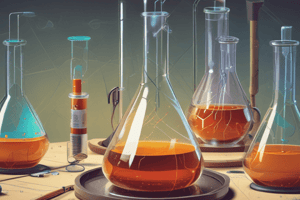Podcast
Questions and Answers
Which technique is commonly used to solve chemistry problems and convert units?
Which technique is commonly used to solve chemistry problems and convert units?
- Calculator
- Dimensional Analysis (correct)
- Factor-label method
- Mathematical shortcuts
What is the purpose of using dimensional analysis?
What is the purpose of using dimensional analysis?
- To stay organized while solving problems
- To avoid making mistakes
- To double-check your work
- All of the above (correct)
What is the result of multiplying a number by 1?
What is the result of multiplying a number by 1?
- The original number (correct)
- A smaller number
- A larger number
- Zero
Which of the following is the correct conversion factor for converting hours to minutes?
Which of the following is the correct conversion factor for converting hours to minutes?
Which of the following is the correct conversion factor for converting miles to centimeters?
Which of the following is the correct conversion factor for converting miles to centimeters?
Which of the following is the correct conversion factor for converting feet to inches?
Which of the following is the correct conversion factor for converting feet to inches?
Which conversion factor would you use to convert grams to kilograms?
Which conversion factor would you use to convert grams to kilograms?
What is the correct conversion factor to convert milliliters to liters?
What is the correct conversion factor to convert milliliters to liters?
What is the final answer when converting 0.8 g/mL to kg/L?
What is the final answer when converting 0.8 g/mL to kg/L?
What is the correct order of operations when converting units?
What is the correct order of operations when converting units?
Flashcards are hidden until you start studying
Study Notes
Chemistry Problem-Solving Techniques
- Dimensional analysis is the technique commonly used to solve chemistry problems and convert units.
- It helps ensure that equations are dimensionally consistent and aids in converting from one unit to another effectively.
Purpose of Dimensional Analysis
- The primary purpose is to verify that equations are properly set up and to convert measurements into desired units without losing accuracy.
Multiplying by One
- Multiplying a number by 1 results in the original number, as this operation does not change the value.
Conversion Factors
- Correct conversion factor for converting hours to minutes: 60 minutes = 1 hour.
- Correct conversion factor for converting miles to centimeters: 1 mile = 160,934.4 centimeters.
- Correct conversion factor for converting feet to inches: 1 foot = 12 inches.
- Conversion factor for converting grams to kilograms: 1,000 grams = 1 kilogram.
- Correct conversion factor to convert milliliters to liters: 1,000 milliliters = 1 liter.
Conversion Example
- Converting 0.8 g/mL to kg/L: The final answer is 800 kg/L, obtained by multiplying by 1,000 (since 1 g/mL equals 1,000 kg/L).
Order of Operations for Unit Conversion
- The order involves identifying the units to convert, applying the correct conversion factors sequentially, and ensuring dimensional consistency throughout the calculation.
Studying That Suits You
Use AI to generate personalized quizzes and flashcards to suit your learning preferences.





